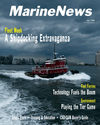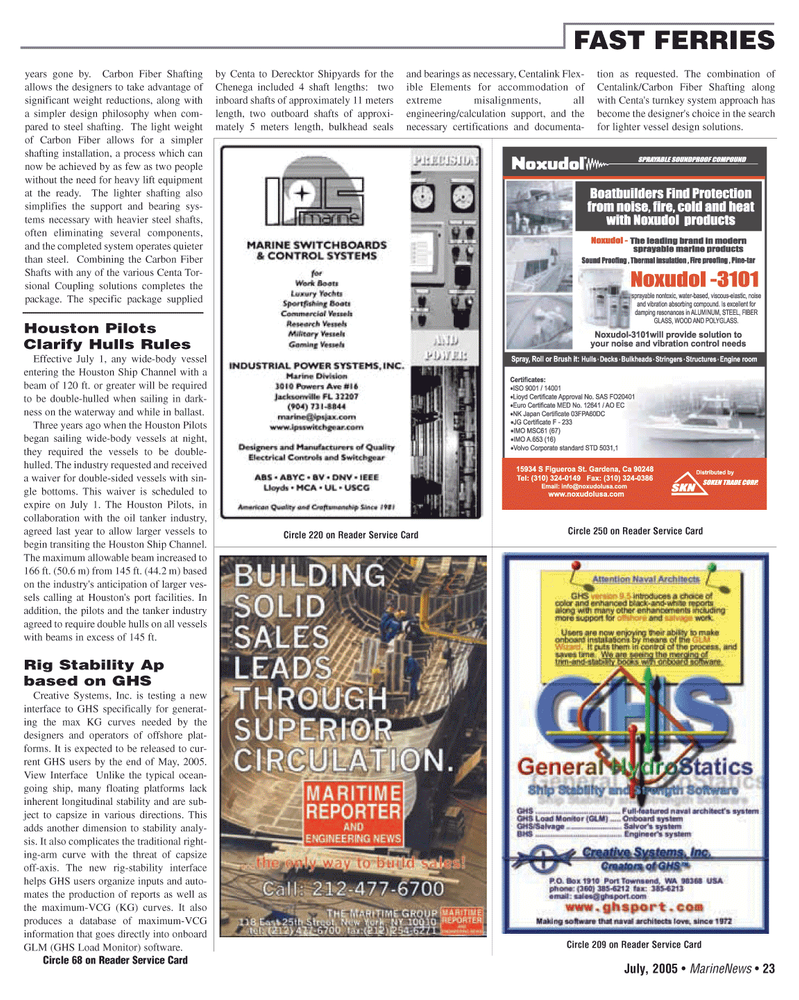
Page 23: of Marine News Magazine (July 2005)
Read this page in Pdf, Flash or Html5 edition of July 2005 Marine News Magazine
July, 2005 • MarineNews 23 years gone by. Carbon Fiber Shafting allows the designers to take advantage of significant weight reductions, along with a simpler design philosophy when com- pared to steel shafting. The light weight of Carbon Fiber allows for a simpler shafting installation, a process which can now be achieved by as few as two people without the need for heavy lift equipment at the ready. The lighter shafting also simplifies the support and bearing sys- tems necessary with heavier steel shafts, often eliminating several components, and the completed system operates quieter than steel. Combining the Carbon Fiber
Shafts with any of the various Centa Tor- sional Coupling solutions completes the package. The specific package supplied by Centa to Derecktor Shipyards for the
Chenega included 4 shaft lengths: two inboard shafts of approximately 11 meters length, two outboard shafts of approxi- mately 5 meters length, bulkhead seals and bearings as necessary, Centalink Flex- ible Elements for accommodation of extreme misalignments, all engineering/calculation support, and the necessary certifications and documenta- tion as requested. The combination of
Centalink/Carbon Fiber Shafting along with Centa's turnkey system approach has become the designer's choice in the search for lighter vessel design solutions.
Circle 220 on Reader Service Card
Circle 250 on Reader Service Card
Circle 209 on Reader Service Card
FAST FERRIES
Houston Pilots
Clarify Hulls Rules
Effective July 1, any wide-body vessel entering the Houston Ship Channel with a beam of 120 ft. or greater will be required to be double-hulled when sailing in dark- ness on the waterway and while in ballast.
Three years ago when the Houston Pilots began sailing wide-body vessels at night, they required the vessels to be double- hulled. The industry requested and received a waiver for double-sided vessels with sin- gle bottoms. This waiver is scheduled to expire on July 1. The Houston Pilots, in collaboration with the oil tanker industry, agreed last year to allow larger vessels to begin transiting the Houston Ship Channel.
The maximum allowable beam increased to 166 ft. (50.6 m) from 145 ft. (44.2 m) based on the industry's anticipation of larger ves- sels calling at Houston's port facilities. In addition, the pilots and the tanker industry agreed to require double hulls on all vessels with beams in excess of 145 ft.
Rig Stability Ap based on GHS
Creative Systems, Inc. is testing a new interface to GHS specifically for generat- ing the max KG curves needed by the designers and operators of offshore plat- forms. It is expected to be released to cur- rent GHS users by the end of May, 2005.
View Interface Unlike the typical ocean- going ship, many floating platforms lack inherent longitudinal stability and are sub- ject to capsize in various directions. This adds another dimension to stability analy- sis. It also complicates the traditional right- ing-arm curve with the threat of capsize off-axis. The new rig-stability interface helps GHS users organize inputs and auto- mates the production of reports as well as the maximum-VCG (KG) curves. It also produces a database of maximum-VCG information that goes directly into onboard
GLM (GHS Load Monitor) software.
Circle 68 on Reader Service Card
JULYMN2005 3(17-24).qxd 6/30/2005 12:14 PM Page 23

 22
22

 24
24
